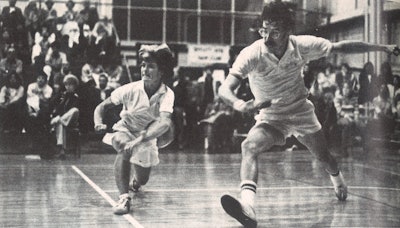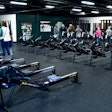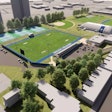
This article originally appeared in the November 1980 issue of AB with the headline, “Will Badminton be the Next ‘Boom’ Sport?”
The past decade was a period of tremendous growth for two popular participant racquet sports—tennis and racquetball. Millions of Americans picked up a racquet and started playing, as commercial tennis and racquetball clubs sprang up all across the United States.
But what will the 1980s bring? Economic changes may result in shifts in the consumer’s ability to pay for play. How will the commercial clubs cope with rising costs, which may push club fees and court time beyond the reach of many racquet sport enthusiasts?
A look at other industries already facing comparable problems may offer valuable insight. A parallel of sorts can be seen in recent trends in the automobile industry. Over the past two years, the industry has moved dramatically from the larger models toward the smaller, more fuel-efficient cars. This unprecedented shift in consumer demand is a complete reversal of the trend of the previous seven decades. The sleek, fuel-efficient import models are in great demand, while domestic manufacturers struggle to catch up.
Badminton is No. 1 Participant Sport in England
The racquet sport that could flood the U.S. market in the 1980s is also an import. It’s the No. 1 participant sport in England; with six million serious players, it’s more popular than soccer. And, it’s supported by a very large following in Northern Europe, Asia, Canada and the Caribbean. The No. 1 North American player is from Mexico. The sport? Indoor Badminton.
Indoor badminton’s popularity has gained considerable momentum in the U.S. in the last few years. There is a large base of players in Southern California; and the United States Badminton Association (USBA), the sanctioning body in the U.S., reports a 300 percent increase in membership from the 1978 to the 1979 season.
The reasons for the present and future growth of the sport are quite sound. When played indoors on a competitive basis, badminton is a fast, active, invigorating sport that can be played and enjoyed by people with a wide range of athletic ability.
For the beginner, it can be a very slow-paced game. For the more accomplished player or the young athlete, it can be the fastest, most grueling of all racquet sports, with the bird leaving the head of the racquet at speeds approaching 200 miles per hour before decelerating rapidly. There are hundreds of shot variations on the 15 basic strokes, and rallies account for 40 percent of the playing time.
The current growth of badminton in the U.S. is due in large part to its recently having become an open sport. Tournament prize money and commercial sponsorship is just beginning to grow in badminton worldwide. A similar occurrence in the late 1960s helped launch open tennis to its meteoric rise in popularity.
The actual growth of any popular participant sport tends to follow a predictable pattern. First, the sport must possess the ability to appeal to a broad cross-section of the population. The broader the potential base of appeal in both demography and geography, the greater the growth potential.
The early stage of development provides growth through the enthusiasm and appeal generated by its participants. Growth occurs primarily because of the abilities of existing players to sell the sport to friends, family and associates. The duration of this phase varies greatly; for tennis, it lasted nearly 80 years.
Commercial Value Propels Sport into ‘Boom Period’
The second stage of growth is that which is known as the “boom period.” Bowling experienced it during the 1950s, golf during the ‘60s and tennis and racquetball during the ‘70s. Characteristic of this phase is the dramatic increases in the number of participants and facilities.
It is normally commercial value that propels a sport into the “boom.” Corporate sponsors begin to realize its value for advertising and promotion. Manufacturers begin to realize the market potentials and invest in product development and advertising. The entrepreneur finds profit incentive in developing facilities and services. High dollar tournaments that attract the sport’s top athletes develop and the excitement and action of the sport is often brought in person or on television to millions of potential participants.
Unlike the early stage of development, growth now is stimulated primarily by forces outside the sport. The duration of the boom will depend upon many factors, including, but not limited to, general economic and social conditions, the cross section of society that the sport appeals to, availability of facilities and media coverage.
As the growth rate eventually peaks, the sport enters the third stage of development. At this point the market is said to have matured. This is a highly unpredictable period. Growth has moderated, and its direction is no longer certain to be up. Facility construction has slowed to a very modest pace. Industry that relies heavily on the beginner market to sell its products or services may begin to suffer.
At this point, the sports facility finds that a creative approach is needed, more than ever, to generate new business. For many, diversification holds the key to continued financial well-being.
Economics Favor Diversification
An economic comparison shows that at today’s cost of construction, an indoor tennis club invests approximately $125,000 per indoor tennis court. Assume a court fee of $10 per hour. The club must rent 12,500 hours to return the investment from court fees.
If one tennis court is converted to five racquetball courts, the economics change. Including the initial investment of $125,000 for the tennis court, plus $55,000 for each of five racquetball courts, the total investment is $400,000, or $80,000 per racquetball court. At a court fee of $10 per hour, 8,000 hours of rental time per court are required to return the investment from court fees.
With the conversion, the club has effectively reduced its debt service per court by 36 percent and increased its salable membership by 400 percent over the original single tennis court. The increased membership will also increase traffic and sales in other profit centers such as pro shops, restaurant, etc.
As you can see, the tennis club owner has substantial economic incentive to build and promote racquetball. It is this fact that has helped bring about the growth of racquetball in the last several years. The growth, however, is showing some signs of softening, and may be limited primarily to the institutional market. Racquetball has, to date, been mainly an American sport, with limited international appeal. Also, it’s not particularly well-suited to spectator viewing.
Badminton Requires Smaller Investment
The economic incentives that have favored the expansion of tennis and then racquetball are even more impressive for badminton. An existing indoor tennis court can be converted permanently to as many as five badminton courts. Using portable badminton courts, it can be converted to four courts and still retain its use as a tennis court.
A conversion to a first-class badminton facility can be accomplished with a total budget of less than $10,000. The initial investment of $125,000 for the tennis court, plus the maximum conversion cost of $10,000 culminates in a total investment of $135,000. As for a portable installation of four badminton courts, that amounts to $33,000 per court. At a court fee of $10 per hour, it will take 3,300 hours per court to return the investment.
The total investment necessary for five indoor courts for these three sports are as follows:
Tennis: $625,000
Racquetball: $400,000
Badminton: $137,000
As the automobile industry has shown, the key to continued success is more efficient use of resources. The biggest resource an athletic or tennis club has is the space of its physical plant, and more efficient use of that space will affect future trends.
For indoor tennis singles play, the space required is approximately 3,000 sq. ft. per player. The badminton space requirement is between 440 and 600 sq. ft. per player, and for racquetball, it’s 400 sq. ft. per player.
































